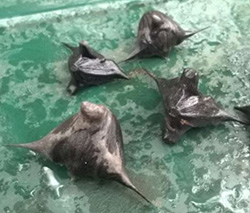Two-horned Water Chestnut
Plant Biology
Two-horned water chestnut (Trapa bispinosa) is a floating annual plant that has a submerged stem and root system. It can grow in slow moving freshwater in lakes, ponds and reservoirs in water up to 12 feet deep. It resembles
Trapa natans from the surface and its life history is very similar. Fan-shaped leaves have doubly serrated margins and form a central rosette with petioles on the leaves that allow them to float. The distinguishing features of
Trapa bispinosa are that its leaves are red on the undersides, it has light pink flowers, and the seed has two opposing horns instead of four. The seed pods are viable for several years and unlike Trapa natans they don't require cold stratification to germinate. Two-horned Trapa flowers and produces fruit from June until frost, with seeds that are viable for two years or more. Both Trapa species can quickly form dense mats of vegetation that can have significant negative impacts on waters it invades. Two-horned water chestnut can create navigational hazards, limit light penetration for submerged plants and reduce dissolved oxygen.


Figures 1 and 2. Flowering Trapa bispinosa rosette (left) seeds pods (right).
Invasion History
Trapa bispinosa was discovered in Pohick Bay, Lorton, Virginia, in 2014. Scientists from Virginia speculated that it was an intentional introduction as an ornamental plant. It has quickly spread to more than 100 water bodies across the state. Though is was identified in 2014, it was likely present in Virginia for many years before being noticed. The seed pods of
Trapa bispinosa can attach easily to the feathers of waterfowl, which is its likely vector of transport.
In the summer of 2022, the Maryland Department of Natural Resources was notified of the presence of
Trapa bispinosa in Greenbelt Lake, the first record for Maryland. Subsequently, three ponds located on the property of the Beltsville Agricultural Research Center (BARC and a small stormwater pond were also found to have
Trapa bispinosa). The larger infestation, located in the ponded area of Beaverdam Creek, covered most of the two-acre surface. These were the first known observations of
Trapa bispinosa in MD.
Current Management
RAS staff worked with BARC staff well as volunteers from the Master Naturalists network, volunteers from Fairfax County VA, the US Geological Survey and the Anacostia Watershed Society to coordinate a manual removal effort using canoes and kayaks. The four-day effort with staff and volunteers was conducted on June 13th through 18th, 2023. More than 180 man-hours were put into the effort to hand pull Trapa.

Figure 3. The plants were harvested and stored in composters (above) to allow the plant material to decompose.
This effort was timed to gather the plants before they flowered to minimize the number of plants that could generate seeds for next year. This effort removed a large amount of plant material, but more than half of the pond was still covered with Trapa at the end of the effort, and by the end of summer the entire pond was covered with plants. BARC staff are actively pursuing a non-tidal wetland permit for this site to drain the pond, which would kill the existing seeds and prevent future growth and spread.